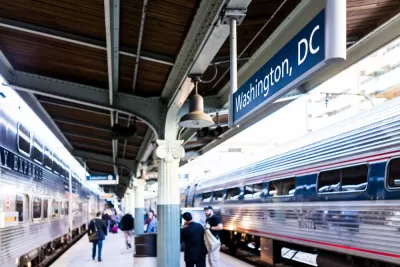The state's consistent investment in passenger rail has resulted in one of the nation's most effective regional rail networks.

As Virginia's commuter traffic grew increasingly worse, state officials bet on passenger rail as a solution, making the state a nationwide leader in rail service. "The quest to get more residents on trains has earned Virginia accolades and a national spotlight, particularly as new transportation priorities in Washington elevate multimodal travel with an eye on reducing greenhouse gas emissions," writes Luz Lazo in the Washington Post. In March of this year, Virginia Governor Ralph Northam "signed a $3.7 billion, wide-ranging deal with Amtrak, commuter rail operator Virginia Railway Express and freight railroad CSX, promising to double passenger service in the state within the decade and create a path to separate freight and passenger traffic."
The state's efforts have included direct involvement such as "purchasing hundreds of miles of passenger right of way from private railroads and negotiating agreements to expand service." Support of rail services, writes Lazo, has brought together Democrats and Republicans in rare agreement. "Whether they’re a Republican from Southwest or a Democrat from Hampton Roads, everybody has wanted to bring better rail service to their communities," says Daniel L. Plaugher, executive director of Virginians for High Speed Rail. "In 2011, under Gov. Bob McDonnell (R), Virginia became one of a handful of states to create a dedicated funding source for rail projects, using a percentage of the state’s retail sales and use tax." Virginia transportation secretary Shannon Valentine argues that reliable, effective rail service is a bipartisan win-win that will make the region "healthier, more connected and more competitive."
FULL STORY: Virginia is a rising leader in passenger rail. Here’s how it happened.

Alabama: Trump Terminates Settlements for Black Communities Harmed By Raw Sewage
Trump deemed the landmark civil rights agreement “illegal DEI and environmental justice policy.”

Planetizen Federal Action Tracker
A weekly monitor of how Trump’s orders and actions are impacting planners and planning in America.

The 120 Year Old Tiny Home Villages That Sheltered San Francisco’s Earthquake Refugees
More than a century ago, San Francisco mobilized to house thousands of residents displaced by the 1906 earthquake. Could their strategy offer a model for the present?

In Both Crashes and Crime, Public Transportation is Far Safer than Driving
Contrary to popular assumptions, public transportation has far lower crash and crime rates than automobile travel. For safer communities, improve and encourage transit travel.

Report: Zoning Reforms Should Complement Nashville’s Ambitious Transit Plan
Without reform, restrictive zoning codes will limit the impact of the city’s planned transit expansion and could exclude some of the residents who depend on transit the most.

Judge Orders Release of Frozen IRA, IIJA Funding
The decision is a victory for environmental groups who charged that freezing funds for critical infrastructure and disaster response programs caused “real and irreparable harm” to communities.
Urban Design for Planners 1: Software Tools
This six-course series explores essential urban design concepts using open source software and equips planners with the tools they need to participate fully in the urban design process.
Planning for Universal Design
Learn the tools for implementing Universal Design in planning regulations.
Clanton & Associates, Inc.
Jessamine County Fiscal Court
Institute for Housing and Urban Development Studies (IHS)
City of Grandview
Harvard GSD Executive Education
Toledo-Lucas County Plan Commissions
Salt Lake City
NYU Wagner Graduate School of Public Service





























